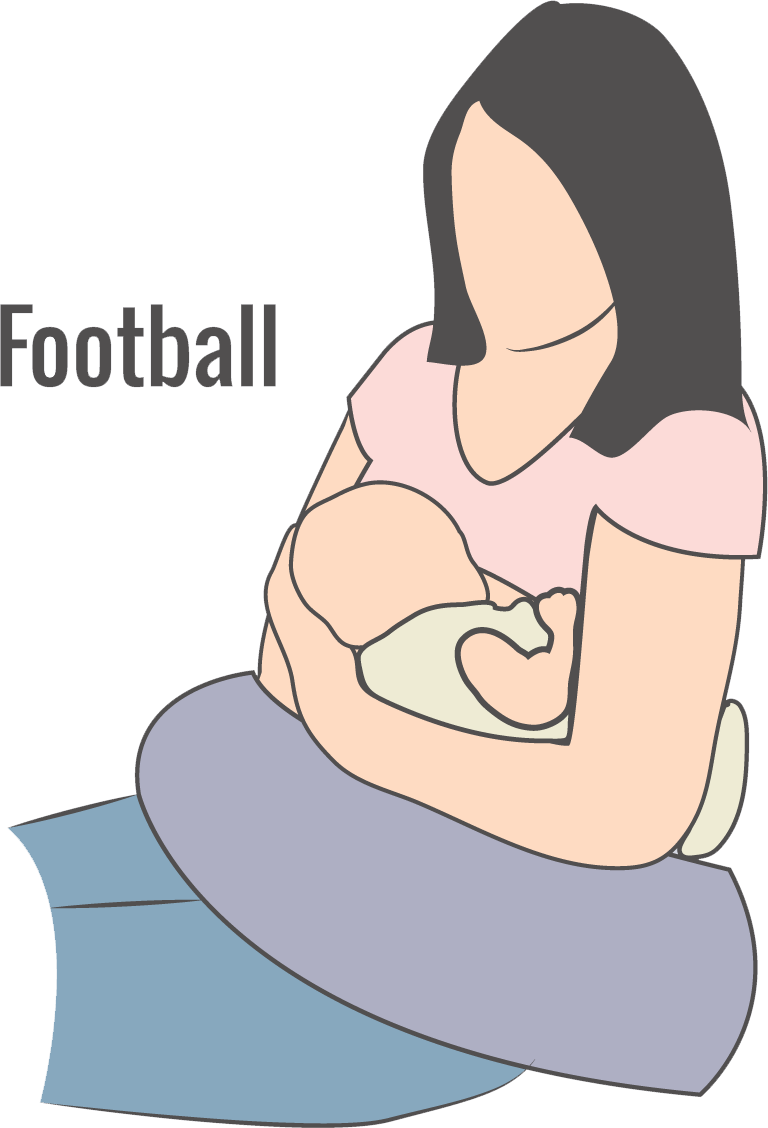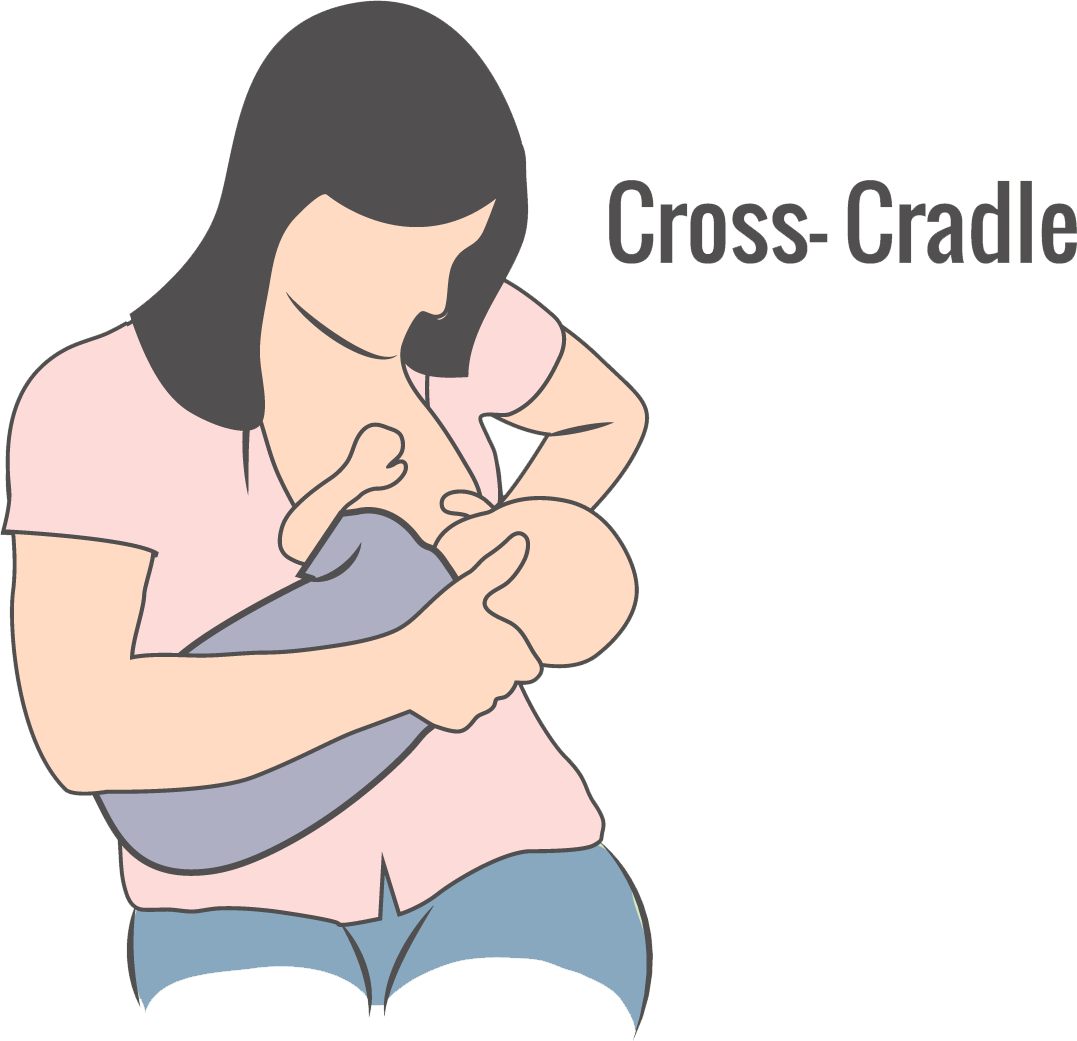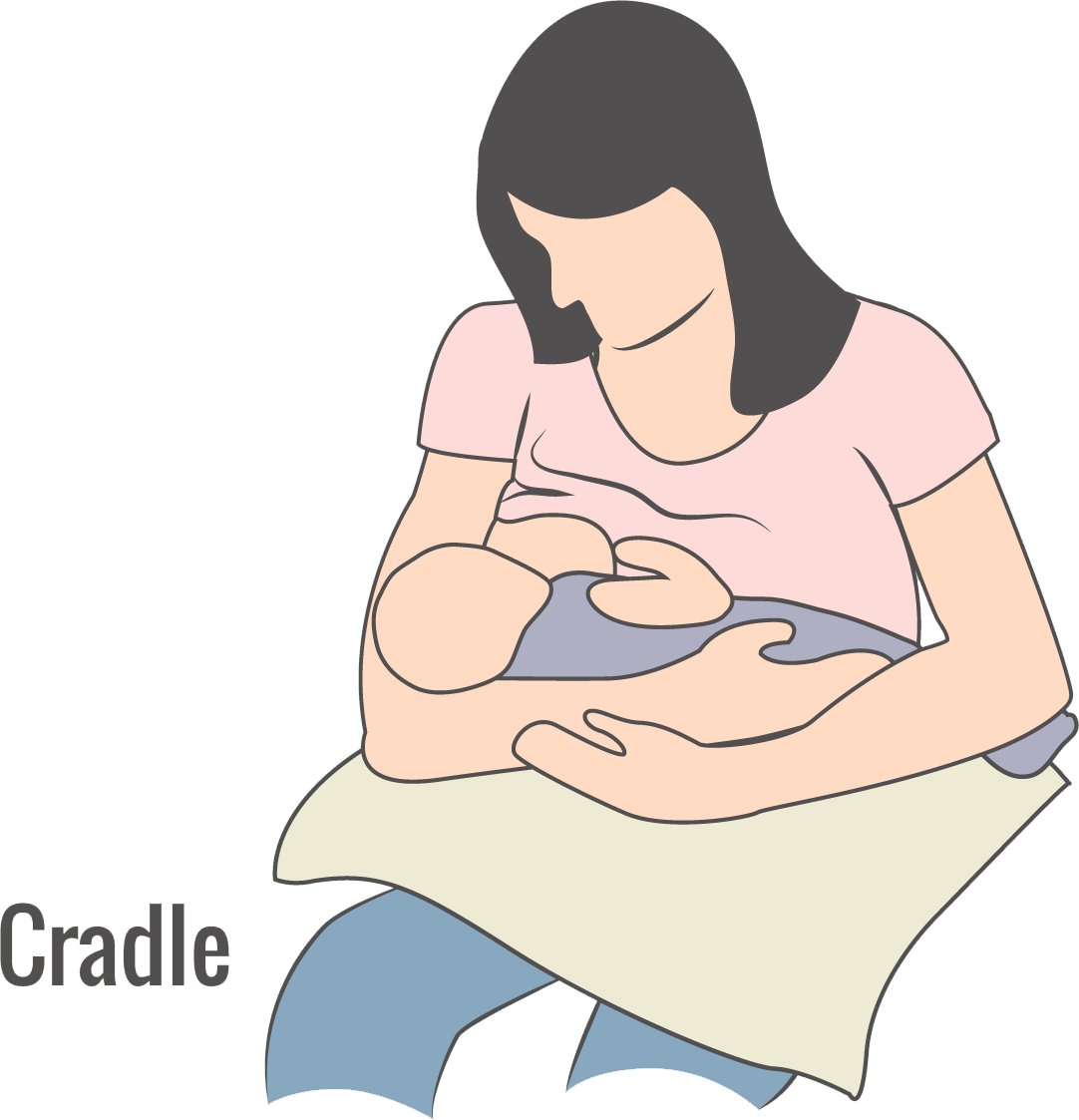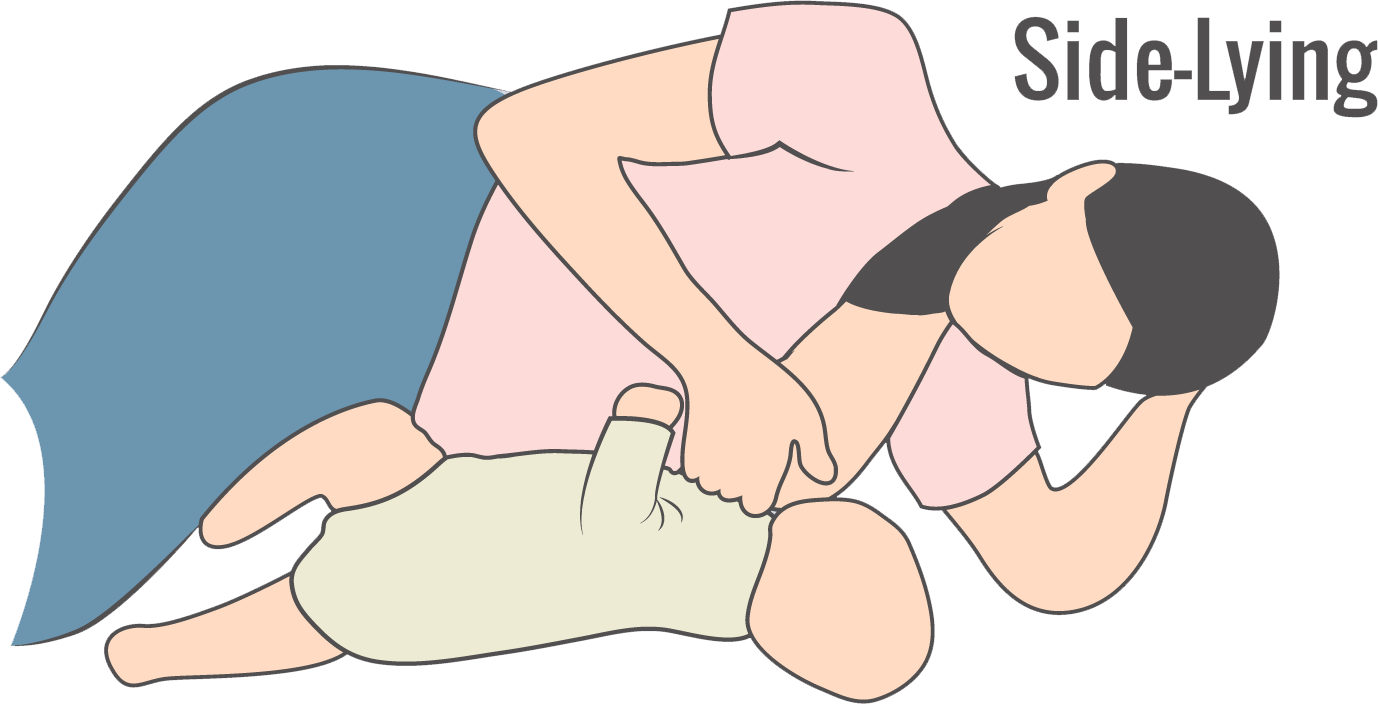Breastfeeding Positions
Changing positions helps improve breast drainage
Changing positions throughout the day will help drain all the quadrants of your breasts and prevent plugging or poor drainage. The portion of your breast that your baby's chin is pointing to, receives the strongest pull and drainage during the feeding. Rotating your baby into a different position at each feeding is suggested, especially for the first week or two, while you and your baby are learning to breastfeed and you are building up confidence in your technique.
Whatever position you choose for the feeding, your baby should always be facing directly to your body—baby's knees, tummy and chest should face your body. Baby's arms should be opened wide and spread around your breast. Use lots of pillows to support your baby, your arms and your back. Foot stools are helpful and prevent strain on your back and muscle tension. Some mothers prefer to use a breastfeeding pillow, available for use with one baby or multiples. Family members and friends can help adjust the pillows for support during feedings. Be sure to take advantage of all the help available. Also be sure to keep a large container of fresh water within reach so you always have something to drink while you are breastfeeding.
Here are some suggested positions to try. You and your baby will eventually find your favorite positions. Initially, learn the cross-cradle, cradle and football positions; these positions give you the most control of your breast and the baby's head—the secret to good positioning.
The football hold
This is a very comfortable position to use immediately after a cesarean section delivery because the baby is positioned away from your incision.

- Sit up supported by pillows and footstool if needed.
- Baby sits on a pillow at your side.
- Baby's body is turned towards you so his/her knees, tummy and chest are facing your body.
- Baby's arms are spread wide around your breast.
- When nursing the right breast, you will hold your breast with your left hand in a "C" hold, shaping your breast and areola into a sandwich for baby to grasp.
- Your right hand will be around your baby's neck, supporting the base of his/her head, your arm supporting his/her back, keeping the baby's body close to you.
- Reverse your hands for nursing the left breast.
The modified football hold
- Sit up supported by pillows and footstool, if needed.
- Baby lies on a pillow at your side.
- Baby's body is turned towards you and wrapped around your body.
- Baby's knees, tummy and chest are facing your body.
- Baby's arms are spread wide around your breast.
- The hand support for your breast and your baby's head are the same as in football; reverse for opposite breast.
The cross-cradle hold
This position is very useful in the early days of breastfeeding because your breast, and the baby's head and body, are well supported. It has also shown to be successful for preterm babies who need extra support and head control.

- Sit up supported by pillows and footstool, if needed.
- Baby lies across the front of your body supported on pillows.
- Baby's knees, tummy, and chest are facing your body.
- Baby's arms are spread wide around your breast.
- Baby's eyes are looking up towards your face (and shoulder).
- When nursing the right breast, you will hold the breast in your right hand in a "U" hold, shaping your breast and areola into a sandwich for baby to grasp.
- Your left hand will be around baby's neck, supporting the base of his/her head while your arm supports his/her back, keeping the baby's body close to you.
- Reverse your hands for nursing the left breast.
The cradle hold
This position is suggested after you and baby are latching without difficulties and baby needs little guidance from you.

- Sit up supported by pillows and footstool, if needed.
- Baby lays across the front of your body supported on pillows baby's knees, tummy and chest are facing your body.
- Baby's arms are spread wide around your breast.
- Baby's eyes are looking up towards your face (and shoulder).
- When nursing the right breast, you will hold the breast in your left hand in a "U" Hold, shaping the breast and areola into a sandwich for baby to grasp.
- Baby's head is supported by your right forearm with your hand supporting baby's bottom. You will use your forearm to guide your baby onto your breast (placing baby's head in the "crook" of your arm often places baby's mouth far to the side and at the wrong angle to latch onto your breast).
- Reverse your hands for nursing the left breast.
Traditional side-lying

- Lie completely on your side, knees bent, supported by pillows between your knees, behind your back, and under your head (body pillows are great support).
- Baby lies on his/her side with tummy, knees and chest facing your body, lower arm tucked under your breast, top arm on top of your breast.
- Baby's face is looking at your breast with his/her mouth level with your nipple.
- Baby's body is horizontal to your body with his/her feet point towards the bottom of the bed.
- If baby's mouth is lower than your nipple, place a folded towel or baby blanket under baby's head to raise baby's mouth to your nipple.
- You may place a tightly rolled towel or blanket behind your baby to keep baby from rolling onto his/her back.
- When nursing the right breast, you will hold your breast with your left hand in a "C" hold, shaping your breast and areola into a sandwich for baby to grasp.
- Your right arm will form an outline around your baby's body on the bed and will guide baby onto your breast.
- Turn onto your left side and reverse the positions for nursing the left breast.
Upside down side-lying
Follow the directions for traditional side lying, but your bottom arm is raised up and positioned above your head along your pillow.

- Baby lies on his/her side with tummy, knees, and chest facing your body, his/her lower arm tucked under your breast, baby's top arm on top of your breast.
- Baby's face is looking at your breast with his/her mouth level with your nipple.
- Baby's body is horizontal to your body with his/her feet pointing towards the top of your bed.
- If baby's mouth is lower than your nipple, place a folded towel or baby blanket under your baby's head.
- You may place a tightly rolled towel or baby blanket behind your baby to keep baby from rolling onto his/her back.
- When nursing the right breast, you will hold your breast with your left hand in "C" hold, shaping the breast and areola into a sandwich for your baby to grasp while your lower arm is up and under your pillow.
- This is a helpful position to drain the top quadrants of your breast and may be very comfortable after a cesarean delivery if your tummy is sore and swollen.
- You may need help with placing your baby into this position and keeping baby close throughout the feeding.
- Turn onto your left side and reverse the hands for nursing the left breast.
Prone position
This position can be very helpful if you feel that your milk flow is too fast or too forceful for your baby. Gravity slows down the flow.
- Lie flat on your back with your knees bent and use pillows to and support your head.
- Baby lies on your tummy looking down at your breast; arms spread wide around your breast.
- An alternative is to place your baby on his/her tummy, lying on pillows at your side with his/her face looking down at your breast and baby's arms spread wide around your breast.
|
Main Line Health breastfeeding/pumping mothers' groupsFor an opportunity to speak with other breastfeeding or pumping others, to share your experiences, and to check your baby's weight, please join us at any of the following mothers' groups. All groups have a baby scale. There is no charge for any of the groups and no reservations are necessary. Feel free to bring a beverage and a snack, babies and their siblings are welcome. Call 1.866.CALL.MLH (225.5654) for weather cancellations, information about dates, room locations or directions to the group meetings. Please note that the groups do not meet on holidays. Find out more about breastfeeding groups at Main Line Health |
 Content you want, delivered to your inbox
Content you want, delivered to your inbox
Want to get the latest health and wellness articles delivered right to your inbox?
Subscribe to the Well Ahead Newsletter.
